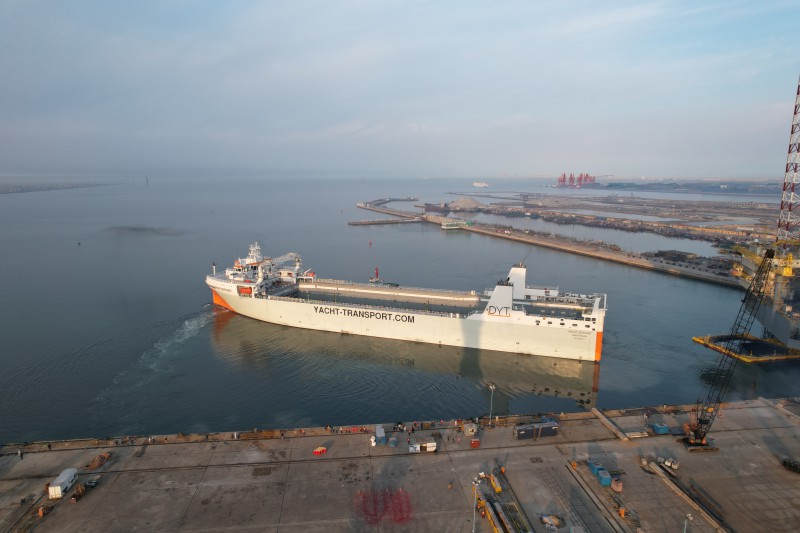214m Yacht Servant - a technical perspective
Capt. Max Stepanov from DYT Operations, shares his insights…
The 214m Yacht Servant represents years of innovation and experience for the Spliethoff Group. Aside from its immense size, there are technical challenges and rewards on offer for this behemoth. Along with its 214m LOA, it has a beam of 46m and a 4.6m draft. Yacht Servant is reported to be IMO Tier-III compliant, with a 30% increase in deck space compared to its sister ship - Yacht Express. After its delivery at the Yantai CIMC Raffles Shipyard on China’s Shandong Peninsula and subsequent departure on its maiden voyage, SuperyachtNews speaks with Max Stepanov, Cargo Superintendent / Operations at DYT Superyacht Transport, for a technical perspective and insight into yacht transport and the idiosyncrasies of Yacht Servant.
 Capt. Max Stepanov from DYT Operations
Capt. Max Stepanov from DYT Operations
One of the defining characteristics of Yacht Servant, along with its size, is its draught considerations. However, as Max explains, there is more to it than meets the eye. “Every coin has two sides. The overall size, specifically the beam, dictates that some ports can consider it to be oversized. Additionally, we have the space considerations astern of the vessel. It is not just the 214m alongside, it is also the space required behind the vessel for the flow of cargo. Sometimes, in terms of alongside space, it can be more like two vessels.”
“What we have is flexibility,” Explains Max “We can utilise anchorages, tying to buoys etc. We have the flexibility in terms of the types of cargo we can carry and the fact that we don’t have to wait alongside. Other vessels may have to wait for two or three weeks in busy ports, which increases the end cost for the customer.”
The draught advantage, as I originally interpreted it, at face value, was that the shallower draught allowed access to more ports by navigating over shallower water. This is only half the truth though, as Max explains: “Comparing to the Yacht Express, the moulded depth of the two vessels is different. Yacht Servant has just 5.9m compared to 8.5m on Yacht Express. When they submerge to the same max draught of 13.5m the level of the water above the main deck is much higher on Yacht Servant, which is 7.6m and 5m respectively.”

The ability to get more water over the deck also opens the Yacht Servant up to more specialized cargo, as Max elaborates. “Having up to 6m clearance on the deck allows us to load more diverse yachts. This extra water level gives us a possibility to load cargo with deeper draft than we have done in the past.”
Safely securing a special cargo requires specialist equipment or ‘gear’ as it is referred to. This is where Max and the team at DYT Superyacht Transport have focussed a lot of their efforts. “We designed the gear for the Yacht Servant from the ground up and we now have all of our onboard gear fully certified by Lloyds Register. We are the only yacht transport company who has done this. Every piece of equipment has its own certification document for compliance in the marine environment.”

“Another key technical component that we utilise on the Yacht Servant is ABB Ability™ OCTOPUS – Marine Advisory System," continues Max. " This system closely monitors the actual accelerations of the vessel and the cargo during transport.” Motion monitoring provides alerts of critical motions and motion forecasting to help with route selection and guides onboard decision-making to optimise safe planning of the voyage ahead.
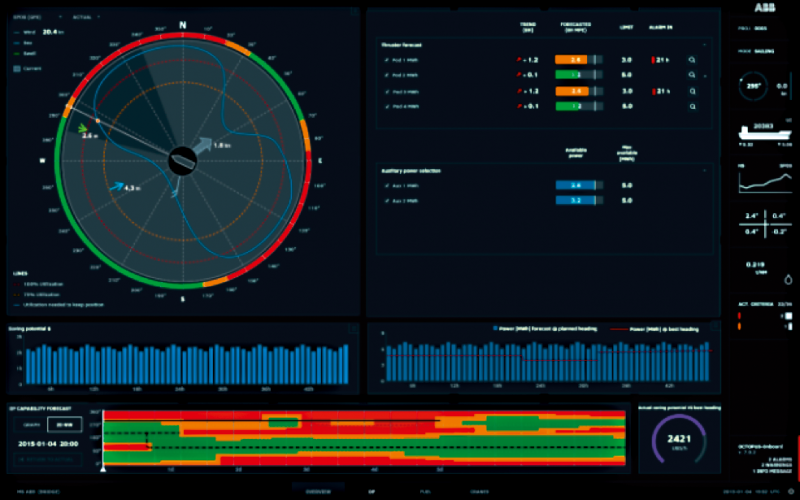 ABB Ability™ OCTOPUS – Marine Advisory System data readout
ABB Ability™ OCTOPUS – Marine Advisory System data readout
“Although we have an excellent track record, we are of the opinion that, by adding OCTOPUS, we offer even better real-time support for the ship’s master and crew to limit unwanted vessel motions at sea, thereby further reducing the risk of damage to the vessel or her cargo,” said Richard Klabbers, managing director of DYT Superyacht Transport in a statement to the media about the technology. “Route planning based on vessel motions and motion forecasting is also a significant safety gain.”
Data collection and interpretation systems are growing in use across the marine industry, with the commercial support and transport sectors leading the way. The transport sector collects specific data points that are advantageous, as Max explains; "The detail comes from the virtual sensors that calculate the acceleration and load at the centre of gravity of the cargo. There are physical sensors also, which when combined with the virtual sensors, calculate a virtual centre of gravity specific to the cargo.”
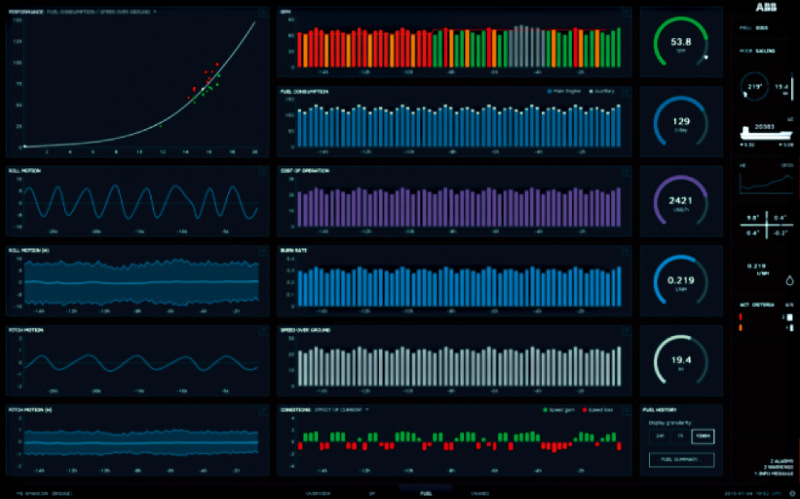 ABB Ability™ OCTOPUS – Marine Advisory System data readout
ABB Ability™ OCTOPUS – Marine Advisory System data readout
“Because the real-time data flow every minute we can see exactly what is happening from our base of operations. This helps us from a technical point of view to optimise the cargo’s lashing and securing system” explains Max. “Typically, a vessel will follow recommendations laid out by safety standards that are generic and set to the worst possible scenario. If you compare that to what we are able to do with OCTOPUS, considering actual hull shape, speed, course and conditions, and combining this with our own specifically designed gear, it is far more efficient and more cost-effective for the customer.”
Undoubtedly, there is less uptake of these integrated monitoring and control systems in the superyacht sector. Understandably, features like cargo-specific sensors may be less applicable, but as the industry strives for greater efficiency and sustainability, should more superyachts be looking to adopt these systems? To conclude I posed the same question to Max: “What you can say is that this system is more utilised in the heavy transport industry and offshore sector rather than in the yacht transport world and here DYT is pioneering as well. However, not so much in the superyacht sector. I think it is because, simply, superyacht users don’t tend to be as situationally aware or feel the need to be as efficient.”
Profile links
NEW: Sign up for SuperyachtNewsweek!
Get the latest weekly news, in-depth reports, intelligence, and strategic insights, delivered directly from The Superyacht Group's editors and market analysts.
Stay at the forefront of the superyacht industry with SuperyachtNewsweek
Click here to become part of The Superyacht Group community, and join us in our mission to make this industry accessible to all, and prosperous for the long-term. We are offering access to the superyacht industry’s most comprehensive and longstanding archive of business-critical information, as well as a comprehensive, real-time superyacht fleet database, for just £10 per month, because we are One Industry with One Mission. Sign up here.
Related news
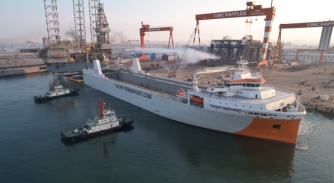
DYT Superyacht Transport announces delivery of 214m Yacht Servant
The new edition to the DYT fleet is the world’s largest purpose-built semi-submersible transport vessel
Fleet
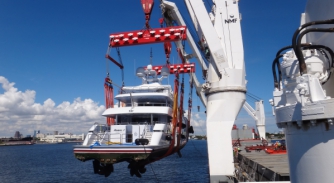
Transporting superyachts in a changing world
Simon Judson, CEO of Peters and May, discusses the challenging logistics of pandemic era transport
Crew

One to One: Richard Klabbers
Managing Director of Sevenstar and DYT Yacht Transport discusses the future of superyacht migration and transport
Business
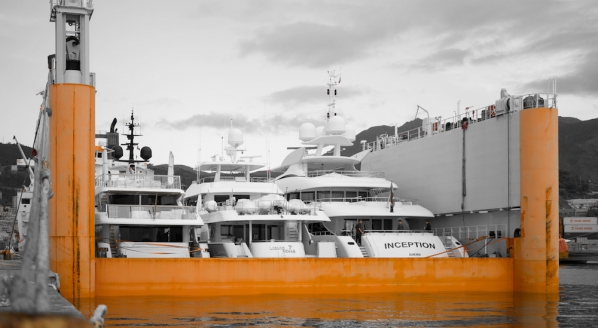
Infrastructure in transit
We speak to DYT about how the yacht transport market needs to develop in tandem with the new build market
Fleet
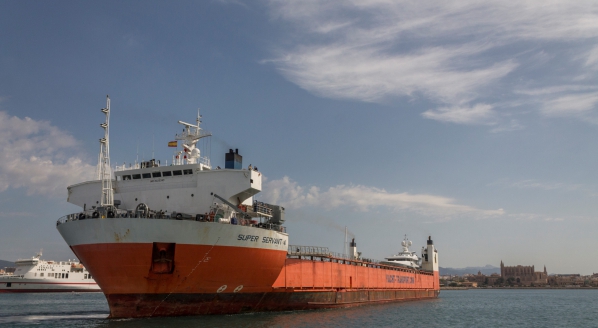
DYT's 'Super Servant 4' departs Palma safely following incident
The yacht transport vessel had unexpectedly listed heavily to starboard during load-out
Business
Related news
Transporting superyachts in a changing world
4 years ago
One to One: Richard Klabbers
5 years ago
Infrastructure in transit
5 years ago
NEW: Sign up for
SuperyachtNewsweek!
Get the latest weekly news, in-depth reports, intelligence, and strategic insights, delivered directly from The Superyacht Group's editors and market analysts.
Stay at the forefront of the superyacht industry with SuperyachtNewsweek


